|
Home
Methods
Tools
Workbench
Emerging
Links
About
Contact
Galleries: Stone
Wood
Other
History...



|
|
European
Sculpture in the 20th.C
Modernist sculpture movements include: Cubism,
Geometric abstraction, Contructionist, Dada,
Surrealism, Futurism, Pop-art, Minimilism, and Installation art among others...
Many of these "movements" are just tags created by art
"academics" for their own convenience in pidgeon-holing.
I think its best to concentrate on the sculptors
themselves and leave "isms" to the writers. This brief guide looks
at the most significant European sculptors of the 20th.C
|
|
|
Constantin Brancusi 1876 - 1957
Romanian, he grew up in a village in the Carpathian mountains, where from
age 7 he herded the family's flock of sheep, and developed a talent for
carving wooden farm tools. He ran away from home to escape the bullying of
his father, and worked as a domestic in a public house in Craiova. When he
was 18, he made a violin from materials he found around his workplace. This
led to him enrolling in the Craiova School of Arts and Crafts, where he
pursued his love for woodworking. After that he enrolled in the Bucharest
School of Fine Arts and trained in sculpture.
In 1903 he travelled to Munich then to Paris and worked for two years in
the workshop of sculptor Antonin Mercie. He was
invited to work in Rodin's workshop but left after 2 months saying
"nothing can grow under big trees".
After this he began developing the abstracted, simplified style for which
he is known. He also switched to direct carving, rather than modeling in clay which was the method popular with his
contemporaries.
His circle of friends in Paris included many artists and intellectuals, and
he was fond of living it up, but at home he continued to dress and live
like a Romanian peasant.
|
|
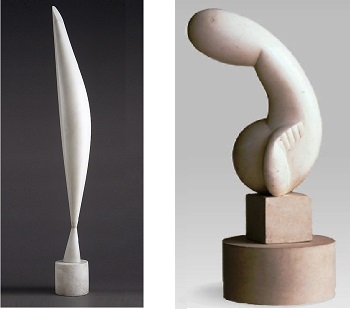
|
|
Jacob Epstein 1880 - 1959
Born in New York, the third of five children, his parents were middle class
Polish Jewish refugees. His interest in art started in childhood during
long periods of illness. He studied art in New York as a teenager and
joined the Art Students League in 1900. He worked in a bronze foundry by
day while studying sculpture in the evenings.
He emigrated to Paris in 1902 and studied the Académie
Julian and the École des Beaux-Arts. He moved to
London in 1905, got married and became a British citizen. Although he
remained married Epstein had a number of relationships with other women
that brought him five children. His wife tolerated his affairs and allowed
his models and lovers to live in the family home, except for one, who she
shot in the shoulder. Yay.
He was commissioned to create sculpture for some of London's most prominent
places, but much of his work appalled and disgusted the general public,
especially his male nudes which were often "vandalised" with a Bobbit. On one sculpture, "Day", Epstein was
forced to reduce the size of the penis after protests from the public. [strange
reaction, because the boy's appendage seems to come out of his butt...]
His art was highly original for its time, and had a significant influence
on the younger generation of sculptors such as Henry Moore and Barbara
Hepworth.
|
|

|
|
Pablo Picasso 1881 - 1973
Spanish, born in Malaga the first child of a middle-class catholic family.
His father was a professor of art at the School of Crafts, and specialized
in naturalistic paintings of birds. From the age of 7, Picasso received
training in drawing and painting from his father, including copying the
masters, and figure drawing from plaster casts and live models. In 1895 his
family moved to Barcelona, and Pablo regarded the city as his true home.
His father arranged for him to take an entrance exam and he was admitted to
the School of Fine Arts. Next, his father sent the young artist to Madrid's
Royal Academy at age 16. Pablo disliked formal instruction and stopped
attending classes soon after enrollment. In 1900
he went to Paris, the art capital of Europe. There, he met poet Max Jacob,
who helped Picasso learn the language.
His work went through several distinct styles known as the Blue, Rose,
African, Cubist and Crystal periods. In 1907 Matisse introduced him to
African sculpture, and the masks had a huge influence on his subsequent
work.
Picasso was one of the most innovative artists ever, but he was
essentially a painter, and had no training as a sculptor - "he
approached sculpting with the freedom of a self-taught artist". His
contribution to the evolution of sculpture was that he removed many
traditional restraints on style, subject matter, methods and materials - he
co-founded the Cubism, and invented "Constructed" sculpture.
|
|

|
|
Frank Dobson 1886 - 1963
English, born in London, his father was a commercial artist who specialized
in bird and flower designs for greeting cards. When his father died the 14
year old Dobson was sent to live with an aunt in Hastings. There he attended
evening classes at the Hastings School of Art, then trained as an
apprentice with sculptor William Reynolds-Stephens for 18 months. He then
moved to Cornwall where he lived by selling paintings. In 1906 he won a
scholarship to the Hospitalfield Art Institute in
Scotland and studied there for four years. From 1910 to 1912 he attended
the City & Guilds of London Art School, after which he returned to
Cornwall. In Newlyn, he met Augustus John who
used his influence to enable Dobson to stage a one-man show in London in
1914.
After WWI he switched from painting to sculpture, in a more or less realist
style. In the 1920s and 1930s he built a reputation as a sculptor and took
to direct carving rather than clay modelling which was the norm. The
monumental dignity of his work was in the tradition of Maillol, and like
him Dobson found the female nude the most satisfactory subject for
3-dimensional composition. The simplified forms and flowing lines of his
sculptures showed the influence of African art. In 1946 he became a
Professor of Sculpture at the Royal College of Art. He was elected to the
Royal Academy in 1953.
Dobson was one of the most esteemed artists of his time, but after his
death his popularity declined with the move towards postmodernism and conceptual
art. In recent years there has been a revival of interest, and he is now
seen as one of the most important British sculptors of the 20th century.
|
|
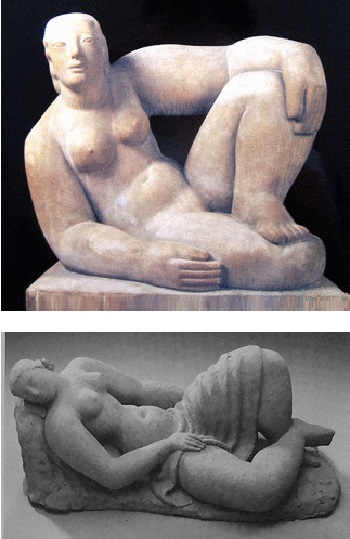
|
|
Jean/Hans Arp 1886 - 1966
German-French, born in Strasbourg, the son of a French mother and a German
father. The area of Alsace-Lorraine went from being french
to german, then back to french,
consequently Arp had both french and german names.
(I once thought there were 2 brothers...)
He went to École des Arts in Strasbourg then
studied at Kunstschule in Weimar, then in 1908
went to the Académie Julian in Paris. In 1912, he
went to Munich where he met and was encouraged by Wassily
Kandinsky. He exhibited with the Der Blaue Reiter
group, and took part in an exhibition in Zürich, along with Kandinsky and
Matisse. In 1915, he avoided being drafted into the German Army and moved
to Switzerland to take advantage Swiss neutrality. He was a founding member
of the Dada movement in Zürich in 1916. In 1920, along with Max Ernst, he
set up the Cologne Dada group. In 1925, his work also appeared in the first
exhibition of the Surrealist group in Paris. In 1931 he broke with the
Surrealist movement to found the Abstraction-Création
in Paris.
In the 1930s, he switched from painting and collage to sculpture, in bronze
and stone. He sought a concrete art: sculptures which identify themselves
with natural forms, without description. From 1954 onwards he received many
international awards for his sculpture.
|
|
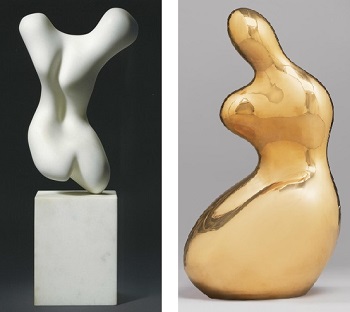
|
|
Alexander Archipenko 1887 - 1964
Ukranian, born in Kiev, the younger brother of
Eugene Archipenko. From 1902-05 he attended the Kiev Art School. In 1906 he
had an exhibition with Bogomazov in Kiev. Later
that year he moved to Moscow and exhibited his work in various group shows.
He moved to Paris in 1908 and was a resident in the artist's colony La
Ruche. In 1910 he exhibitied at Salon des Indépendants with Picasso and Braque, the first public
showing of Cubism in Paris. In 1912 he had his first solo exhibition in Folkwang, Germany. From 1912 to 1914 he was teaching at
his own Art School in Paris. Four of his Cubist sculptures appeared in the
controversial Armory Show in 1913 in New York. In
1921 he started his own Art school in Berlin, then the following year he
participated in the First Russian Art Exhibition in Berlin. In 1923 he
emigrated to America and participated in an exhibition of Russian
Sculpture. He became a US citizen in 1929. In 1933 he exhibited at the
Ukrainian pavilion in Chicago where his works were valued at $25,000. In
1936 he participated in an exhibition of Cubism and Abstract Art in New
York. He was elected to the American Academy of Arts and Letters in 1962.
Archipenko was the first, after Picasso, to use the Cubist style in
sculpture. He used faceted planes and negative space to create a new way of
looking at the human figure, showing a number of views of the subject
simultaneously.
|
|
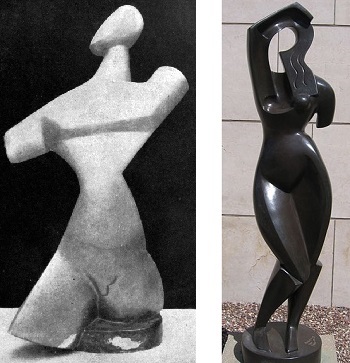
|
|
Henri Gaudier-Brzeska 1891 - 1915
French, born in Orleans as Henri Gaudier, the son of a carpenter. In 1911
he moved to London with polish writer Sophie Brzeska
whom he had met in Paris when he was 20 and she was 38. They
double-barrelled their names, although they never married. They both
suffered from mental health issues and rarely had sex - Sophie would buy
Henri prostitutes for his enjoyment instead of having relations with him.
He initially studied business before the move to London to become an
artist, and had no formal artistic training. He was influenced by Rodin's
figurative style and knew very little about contemporary sculpture. By the
autumn of 1913 his friendships with Ezra Pound and Jacob Epstein pointed
him in the direction of abstraction and a greater bareness and geometrical
simplification. Epstein's carvings encouraged Gaudier to draw upon the art
of non-Western cultures on view at the British Museum. Pound supported the
impoverished Gaudier-Brzeska by purchasing
carvings and he presented him with a block of marble for a specially commissioned
portrait.
His works such as Red Stone Dancer and Seated Woman showed a remarkable
talent and a fresh approach, but, it was short lived because in 1915 he
enlisted with the French army and was killed in the trenches. What a waste.
|
|
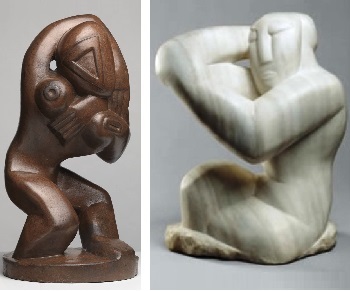
|
|
Henry Moore 1898 - 1988
English, born in Castleford, the son of a coal miner, 7th of eight
children. Henry went to Castleford Grammar School, where his art teacher
broadened his knowledge of art. At 18 he joined the army, and was injured
in a gas attack in France in 1917. After the war he received an
ex-serviceman's grant to continue his education and in 1919 he started at
the Leeds School of Art.
Barbara Hepworth was a fellow student and they began a friendship and
rivalry that lasted for many years. In 1921, Moore and Hepworth both won
scholarships to the Royal College of Art. In London, Moore became
interested in primitive sculpture, and studied the ethnic collections at
the British Museum. This and the influence of sculptors such as Brancusi,
Epstein, Gaudier-Brzeska and Dobson led him to
the method of direct carving. This put him in conflict with his tutors who
wanted him to model in plaster, then reproduce in marble using a pointing
machine.
In 1924, he won a 6-month travelling scholarship which he spent in Italy
studying Michelangelo and other Old Masters. He visited Paris, and viewed a
plaster cast of a Maya sculpture "Chac Mool" - this had a profound effect on him and
the "reclining figure" became a recurring motif in his sculpture.
For the next 6 years he held a part-time teaching post at the RCA, this
allowed him time to spend on his own work. In 1928 he got his first public
commission, "West Wind", which was one of the 8 reliefs on the
walls of London Underground's headquarters. He married Irina Radetsky, a Ukrainian student at the RCA and they moved
to Hampstead and became part of the colony of avant-garde artists (Barbara
Hepworth moved into a studio around the corner). In 1932 he became Head of
Sculpture at the Chelsea School of Art. Artistically, Moore and the other members
of The 7&5 Society began to develop more abstract work, influenced by
trips to Paris and contact with Picasso, Braque, Arp and Giacometti. At the
outbreak of WWII he became a war artist, producing drawings of Londoners
sheltering from the Blitz. When their Hampstead home was bombed in 1940,
Moore and Irina moved to Hoglands - a farmhouse
in the village of Perry Green, Hertfordshire. This was to become Moore's
home and workshop for the rest of his life. After the birth of his daughter
in 1946 Moore's main theme became the "mother-and-child". In the
1950s, he began to get more commissions for public works of art, and as the
scale of his sculptures grew significantly, he started to employ assistants
to work with him at Hoglands.
As his wealth grew, Moore established the Henry Moore Foundation as a
registered charity to encourage public appreciation of his art.
|
|

|
|
Alberto Giacometti 1901 - 1966
Swiss, born in Borgonova, the son of a well known post impressionist
painter, he had 2 brothers who also became artists. He moved to Geneva to
attend the School of Fine Arts. In 1922 he moved to Paris to study under
the sculptor Bourdelle. It was there that he
experimented with cubism then surrealism, and came to be regarded as one of
the leading surrealist sculptors.
Between 1936 and 1940 he concentrated on sculpting the human head, focusing
on the model's gaze. This was followed by a phase in which his sculptures
of his sister Isabel became stretched, with elongated limbs. After his
marriage in 1946 his tiny sculptures became larger, but the larger they
grew, the thinner they became, with rough, eroded, heavily worked surfaces.
He mostly concentrated on the themes of the walking man, the standing nude,
and the bust.
In 1962 he was awarded the grand prize for sculpture at the Venice
Biennale, and the award brought with it worldwide fame. In his later years
Giacometti's works were shown in a number of large exhibitions throughout
Europe and in New York.
|
|
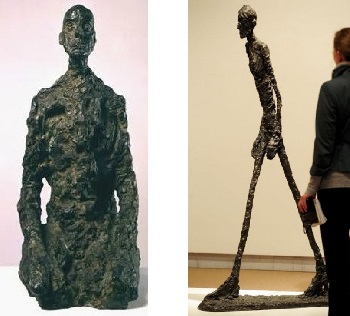
|
|
Barbara Hepworth 1903 - 1975
English, born in Wakefield, the eldest child in an upwardly mobile family.
She won a scholarship to the Leeds School of Art and studied there from
1920. There she became friends with fellow student, Henry Moore, and they
started a friendly professional rivalry that lasted for many years.
Hepworth was the first to sculpt the pierced figures that are
characteristic of works by both.
She then won a scholarship to the Royal College of Art and studied there
from 1921 to 1924. After that she was awarded a scholarship for one year's
travel abroad and went to Florence to study Renaissance art. She met and
married sculptor John Skeaping who was studying
sculpture in Rome. Hepworth learned to carve marble from master-carver
Giovanni Ardini. In 1931 she went on a holiday in
Norfolk with Skeaping, Ben Nicholson, Henry and
Irina Moore and Ivon Hitchens. Later, she
divorced from Skeaping and married Nicholson.
Hepworth's first holed sculpture, "Pierced Form", was carved
around 1932. In 1933 she went to Paris and met Brancusi and Picasso, and
the following year she met Braque at Varengeville.
Hepworth became involved with the Paris-based art movement, Abstraction-Création, and co-founded the Unit One art movement
which sought to unite Surrealism and abstraction in British art.
St Ives had become a refuge for many artists during the war and in 1949
Hepworth and Nicholson moved there and aquired a
studio - she lived there until her death in 1975, when the studio caught
fire.
Hepworth's international standing was recognised with honorary degrees, the
CBE (1958) and the DBE (1965).
|
|

|
|
It's interesting to see how many painters switched to sculpture later in
life. For some it was an epiphany, but, some had made their reputation in
painting, then shamelessly cashed in on that, or their heirs did... So,
there's a few famous names missing from this rough guide because they can't
really be considered "sculptors" at all...
Matisse is quoted as saying "I sculpted as a painter, I did not
sculpt like a sculptor. Sculpture does not say what painting says". He
described his sculpture as "a rest from painting". That didnt stop him casting his 82 sculptural works in
editions of 10. Ker-ching.
Degas created only one piece that was for public view, the rest were
private 3-D sketches. After he died his heirs decided to make bronze casts
of his plasticine and clay pieces. They did 20
casts of each, all stamped "Degas". Ker-ching.
Renoir was in his 70's with hands deformed by athritus
when he decided to try sculpture. He told his friend, Vollard,
"I'm looking for a pair of hands". Vollard
arranged for a young unknown sculptor Richard Guino
to become Renoir's "ghost". Many famous sculptors, including
Rodin, had "assistants" to scale up clay maquettes
into full-sized stone sculptures, but in this case Guino
did 100% of the sculpting, based on Renoir's paintings. His art
dealer friend sold the pieces branded as "Renoir", ker-ching, and Guino was
airbrushed from art history. What a fraud. Guino's
heirs took Renoir's heirs to court and after a 40 years battle the french courts decided the sculptures had to be
re-classified as Renoir/Guino.
Michelangelo and Bernini would roll over in their graves...
|
|
More
Good Sculptors....
To keep it brief the above section only mentions certain key sculptors, but
there are many more well worth a look at.
Here is a selection of the famous and not-so-famous.
|
|
Maurice Lambert
- Father and Child
|
|
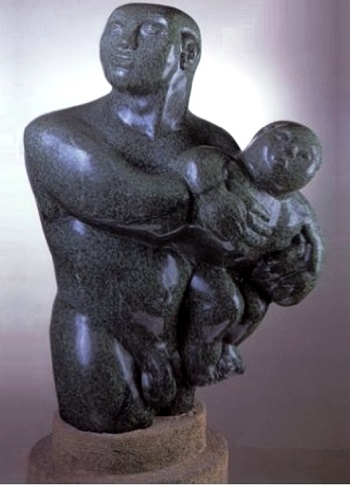
|
|
|
|
|
|
Elizabeth Frink
- Running Men
|
|
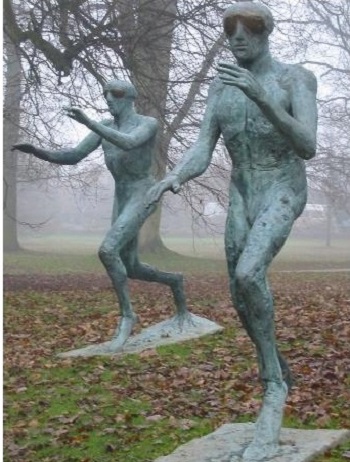
|
|
Unberto Boccioni
- Unique-forms-in-continuity-and-space
|
|
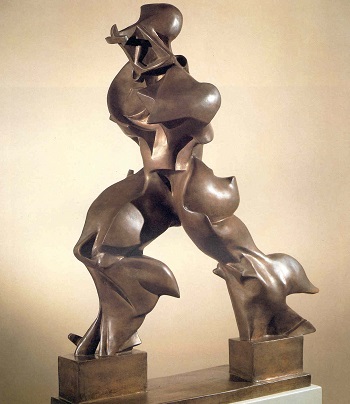
|
|
Naum Gabo
- Constructed Head
|
|
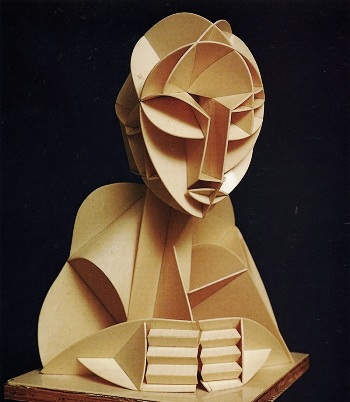
|
|
Eric Gill
- The East Wind
|
|
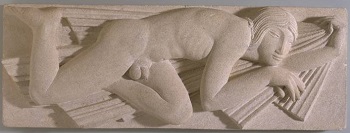
|
|
Georg Kolbe
- Kauernde
|
|
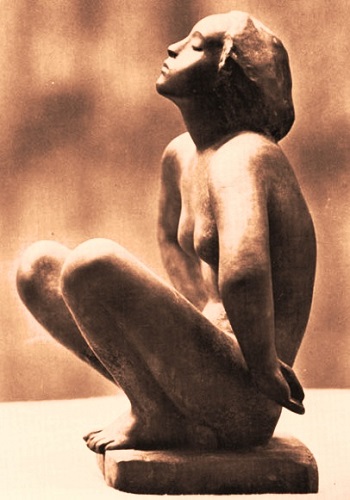
|
|
Gerhard Marcks
- Prometheus
|
|

|
|
Wilhelm Lehmbruck
- Mother and Child
|
|

|
|
Marino Marini
- Angel of the city
|
|
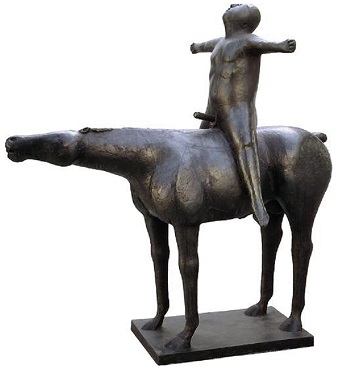
|
|
Alberto Viani
- Woman torso
|
|
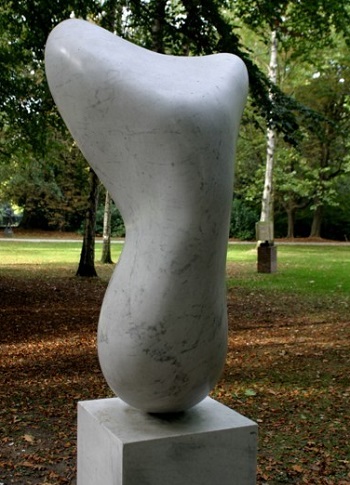
|
|
Alfredo Ceschiatti
- Reclining figure
|
|
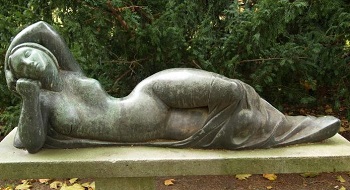
|
|
|
|
|
|
|
|
|
|
|
|
|

